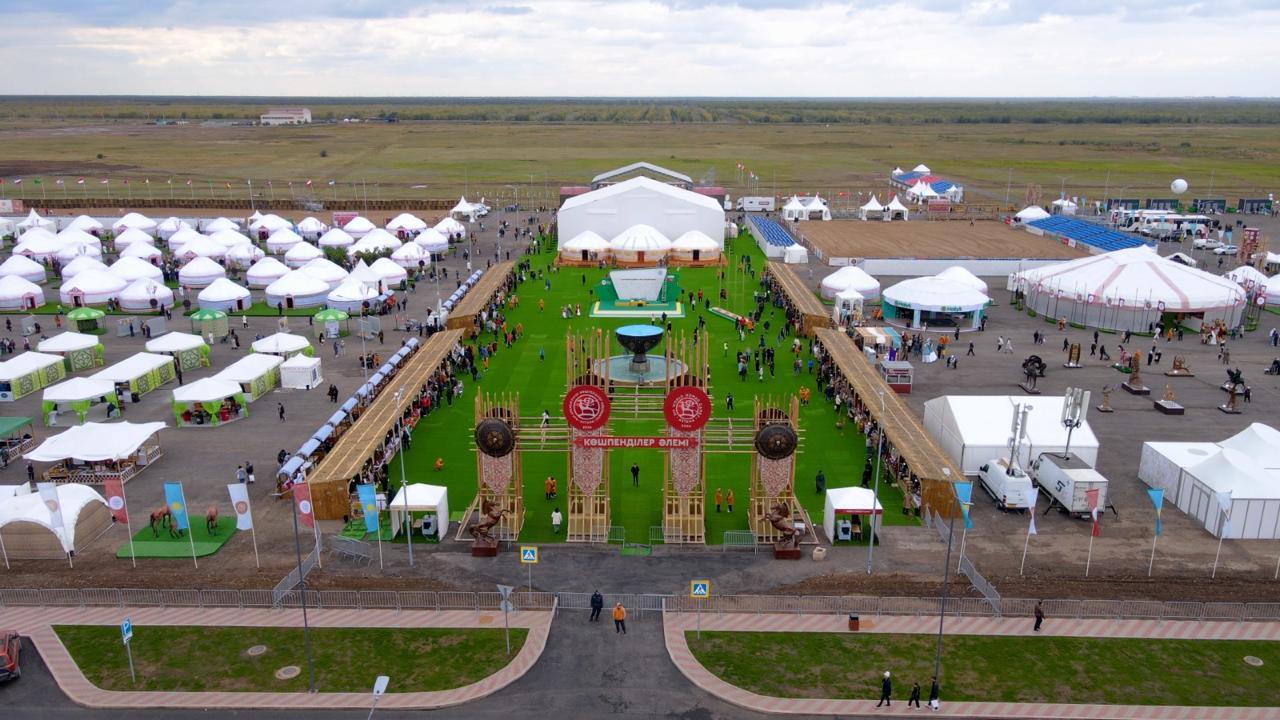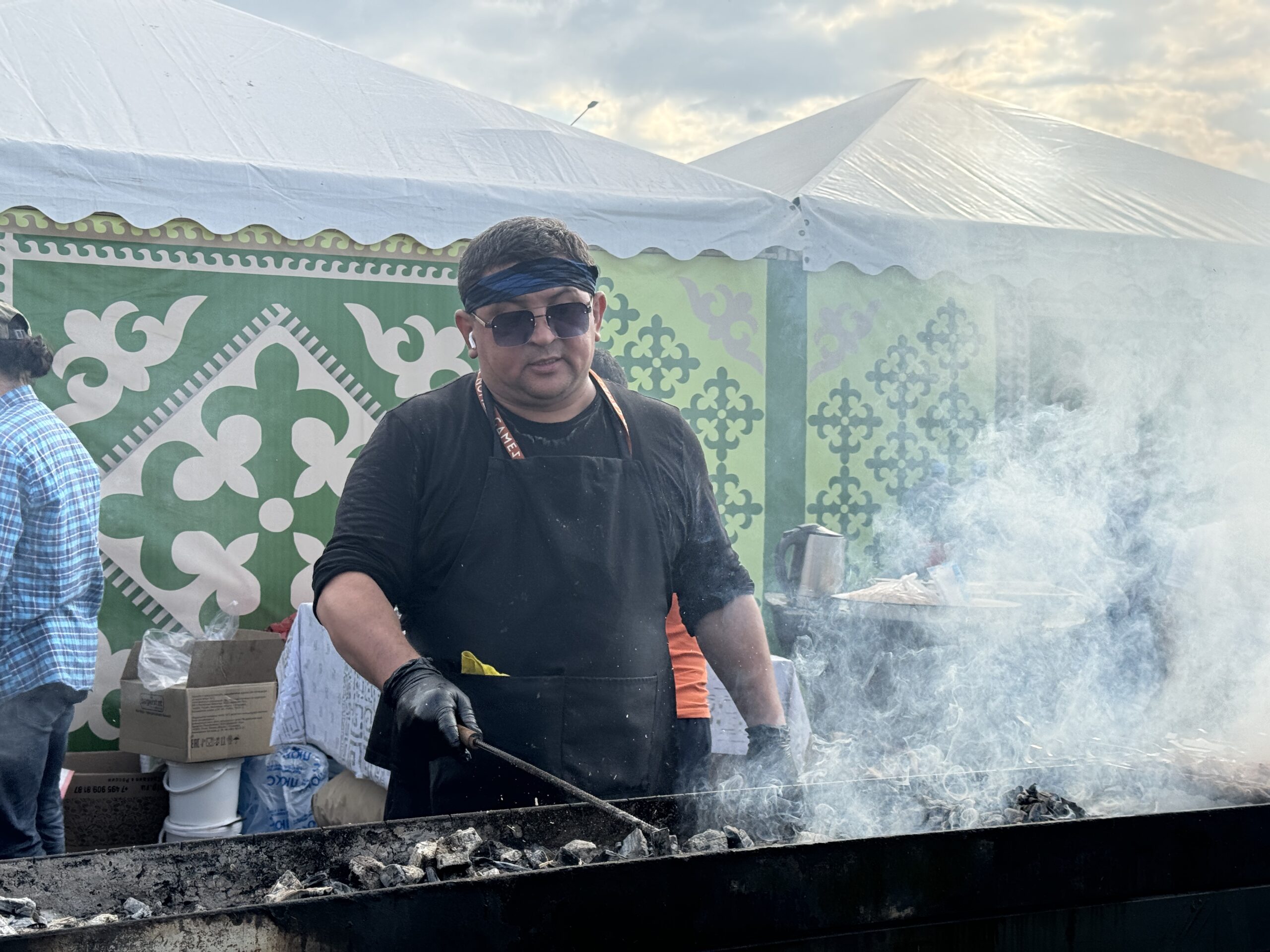ASTANA – Throughout the World Nomad Games which triumphantly folded on the evening of Sept.13, the ethnovillage was a hot spot for locals and tourists to immerse themselves in the rich nomadic heritage, uniting cultures and ancient traditions and giving an opportunity for a bit of adventure within the limits of the city.

The ethnovillage was open to the public free of charge. Photo credit: gov.kz
Spanning 10 hectares near the Kazanat racetrack, one of the sports venues of the games in Astana, the ethnovillage was open to the public from Sept. 7. It had several areas, beginning with a central square with a big taiqazan (a metal cauldron) in the middle. The public enjoyed a folk music tent, an open-air museum of nomadic civilizations, and designated spaces for sports events and national cuisine.
Each region of Kazakhstan also set up yurts to represent distinct features, be it traditions or food. Getting inside, one could hear the sounds from every corner – live music from the stage, the sounds of lively conversations, music, and the clutter of artisans and visitors.
“It is a really impressive atmosphere here. I liked how the ethnovillage is established, especially how different regions are represented,” said Abira Kuandyk, a resident of Astana, in a comment for this story.
Artisan markets brings more than 200 masters
The diversity of handcrafted pieces on display at the artisan market drew the attention of visitors. From traditional jewelry to intricately woven rugs, talented artists continue to keep ancient traditions alive. Visitors seemed eager to take home a piece of the culture.

Events were held daily at the ethnovillage. Photo credit: The Astana Times/ Asse Satubaldina
One of them was Gulmira Aigozhina from the Abai Region in eastern Kazakhstan. She has been engaged in felting for 15 years.
Felting is a textile-making process that involves matting, condensing, and pressing fibers, usually wool, together to create a durable fabric. Unlike weaving or knitting, felting doesn’t require spinning the wool into yarn. Instead, the fibers are interlocked through friction and pressure, often using water and soap to help the fibers bond.
Nomads relied on felt for centuries, either for yurts (mobile homes), clothing or rugs – essential items that supported nomadic lifestyle in harsch climates.

Gulmira Aigozhina came all the way from eastern Kazakhstan. Photo credit: The Astana Times
“I do felting. Why did I choose this craft? First, it is the most practical material. It keeps you warm in winter and cool in summer. For example, if we were to put on this tyubeteika, it wouldn’t be hot, even in warm weather, and it would keep us warm in the cold. Another great quality is its health benefits. When I sell this type of wool scarf, it acts like a warm neck massage, which is incredible,” Aigozhina told The Astana Times.
She also makes small, beautifully decorated rugs depicting ‘boytumar,’ a protective talisman believed to protect the home from evil spirits and keep the family safe.
“The most important thing I want to highlight is the rugs I make. In the past, they used to look different, but now I create these creative rugs, which are not only beautiful but also functional. You can do exercises on them, like physical therapy, or just hang them on the wall. They are also warm if you place them on the floor,” she explained.

Gulmira Aigozhina shows the panno she has made. Photo credit: The Astana Times
Aigozhina expressed joy and optimism about taking part in the grand event. “As for the World Nomad Games, they are fantastic, and there are so many emotions. I haven’t seen anyone in a bad mood, which is amazing. It turns out we are all one. Sometimes, you hear about wars and conflicts, but this shows what we really need—to live, be friends, smile, and inspire each other. There is so much inspiration here. I’m going home with so much energy and positivity,” said Aigozhina.
Paint on the water
Selat Metin came from Istanbul to spread the word and showcase the art of Ebru, an ancient art of marbling or painting on water. The Astana Times watched how, in just five minutes, the artist’s talented hands created awe-inspiring designs. It might look easy from an outsider’s point of view, but Metin said it is not.

Selat Metin shows the process of ebru art. Photo credit: The Astana Times
“The exact date when this art emerged is still unknown. Many say it is the ninth century. The earliest piece in the Topkapi Palace dates back to the 13th century. It actually came from Central Asia to Türkiye, that is, from Central Asia to Iran, then through the Silk Road to Türkiye,” Metin said in an interview for this story.
The name ‘ebru’ originates from Persian and means ‘cloud-like.’ Metin’s movements with his hands and how he touched the water with the brush, using natural colors, felt light.

The process of the art leaves one in awe. Photo credit: The Astana Times
He also shared his impressions of the World Nomad Games, which he deems the “Olympics of the Turkic world.”
“The previous one took place in Iznik, Türkiye, but we couldn’t attend that time. Now, it seems fate has brought us here to Astana. After getting involved, I see this as the Olympics of the Turkic world,” he said.

One can make designs on paper or other materials as well. Photo credit: The Astana Times
He believes the scale of the event will continue to grow.
“The pandemic had caused a delay, but Kazakhstan has now hosted the games for the first time and raised the bar in terms of participants, events, and organization. Whoever hosts the next edition will face a big challenge. I see these events as essential for strengthening the unity within the Turkic world and promoting it on the international stage,” said Metin.
Rich nomadic culinary scene
Food has a fantastic ability to unite people. No visit to the ethnovillage is complete without indulging in its food scene.

The cook prepares shashlyk. Photo credit: The Astana Times/ Assel Satubaldina
Trying new dishes, feeling a variety of flavors and tastes, and sharing impressions – this is what one could witness at the ethnovillage. Whether it is kazy (a horse meet sausage), plov, shashlyk (grilled cubes of meat), or lighter snacks like samsa (pastry usually with minced meet), bauyrsak (puffy fried dough), and drinks like kymyz (fermented mare’s milk) and shubat (camel’s milk), hardly anyone is left disappointed.
Impressions of tourists
Karen Osborne came to Astana from London, specifically for the games. She stayed the whole week to watch the games.
“It is not just the games. It is all the people who take part and come here to this one place. I have a very special interest in the games. It is the skill of the people, the way they interact with animals, but also the national thing, coming together with all the different people, has to be the best. Very proud of you to do it,” she said in a comment for this story.

From L to R: Karen Osborne and Hilary Clark came from the United Kingdom. Photo credit: The Astana Times
For Hilary Clark from Plymouth, the United Kingdom, arriving in Kazakhstan for the World Nomad Games has been a lucky coincidence.
“My friend said she was coming to the World Nomad Games, and I thought that sounds amazing. Actually, I had already booked to go to Kyrgyzstan and Uzbekistan next Saturday. I thought it was an ideal opportunity I can come to the Nomad Games first. I am very interested in seeing different cultures. It is wonderful because everyone is dressed up here,” she said.
Adnan Wana, a traditional archery athlete from Thailand, takes part in the World Nomad Games for the first time.
“It is my first time at the World Nomad Games, and it is amazing. It is my first time in Kazakhstan. I really like it; the people are very polite and kind,” he said.

Families were having fun with their kids at the ethnovillage. Photo credit: The Astana Times/ Assel Satubaldina
Speaking of Kazakh traditional food he tried, he mentioned horse meat and plov. “After the World Nomad Games, I will be traveling around Kazakhstan for a week. I visited Almaty and Shymbulak. It’s very cold here compared to Thailand, where it is 30 degrees Celcius, but here it is around 9-10 degrees Celcius,” he said with a smile on his face.
The World Nomad Games concluded with a closing ceremony broadcast live on national TV channels on Sept. 13. The participants of the games competed in 21 different sports. Throughout the week, approximately 100 cultural events have been held daily in the ethnovillage.


